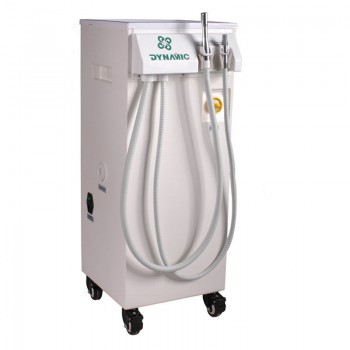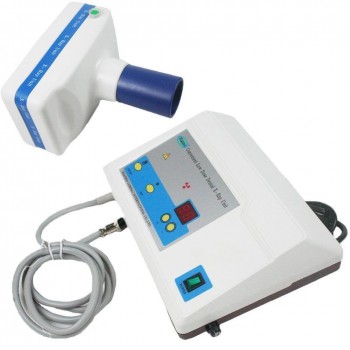Air driven high-speed dental units are driven by a dental air compressor. The entry-level models all have three handpieces. They all provide a water reservoir. Some will provide a spare airline yoke for a second slow-speed hand-piece or a sonic scaler.
Advantages
Very reliable and versatile, if properly maintained.
Allows the practice to grow into more sophisticated level of work, with appropriate training.
Leads to greater job satisfaction for operators.
Disadvantages
Relatively high initial cost compared to other equipment (circa £2,000).
High-speed Hand Piece
The high speed handpiece is capable of up to 400,000 rpm. It takes friction grip burs (FG) and has a water cooling facility for the bur. The water flow supplied to the hand piece can be varied or switched off completely.
The handpiece provides low torque, which causes the bur to stall if pressed too hard onto the tooth (over 1-2 ounces of pressure).
It is used for the drilling of access points into teeth, for high speed sectioning of teeth during extraction and cutting or re-modelling of bone.
The handpiece needs regular lubrication during the session and can be autoclaved.
Air/water Syringe
The air/water syringe has two buttons – one to control water flow and one to control airflow.
It allows a stream of water, air or a fine mist.
Slow Speed Handpiece
The slow speed handpiece has an air-driven motor in the base. It is capable of forward and reverse movement and speeds of up to 30,000 rpm.
The control on the collar controls the speed and direction of the bur.
The slow speed handpiece has a very high torque. It is difficult to stall and can overheat the pulp if used for more than a few seconds on one tooth.
It is very versatile and can accept long HP burs in the nose cone, polishing cups in a prophy angle and, with the contra-angle, right angle (RA) burs or any other type of latch tool. Other latch tools include polishing cups, sanding discs, root canal paste fillers and diamond discs.
Compressor
The size and type of air compressor you may require should be considered at the time of purchase. Reservoirs are available from 4 gallons to 12 gallons supplying between 6-8 cubic feet/min (CFM).
A small compressor has the advantage of being lightweight, quieter and cheaper. However, if asked to work beyond its capacity, it will overheat and cut out. It is often suggested that if the practice intends to perform restorative work it is best to have an oil-less compressor, to prevent oil droplets in the airline contaminating the restorative material.
Compressors are available with motors from 0.5 horsepower (Hp) to a unit with dual 1Hp motors for heavy use.

